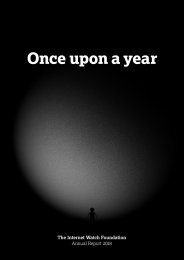You also want an ePaper? Increase the reach of your titles
YUMPU automatically turns print PDFs into web optimized ePapers that Google loves.
4: The results<br />
Trend: Commercial child<br />
sexual abuse material<br />
We define commercial child sexual abuse imagery as images or videos<br />
that were seemingly produced or being used for the purposes of financial<br />
gain by the distributor.<br />
Of the 132,676 webpages we confirmed as containing child sexual abuse<br />
imagery in <strong>2019</strong>, 15,326 (12%) were commercial in nature. This is an increase<br />
on 2018, when we took action against 6,941 (7%) commercial webpages.<br />
Why has there been an increase?<br />
We believe the rise in the number of commercial<br />
hidden services (see page 56) in part accounts for<br />
the increase of commercial content we’ve seen<br />
in <strong>2019</strong>. Hidden services often display thousands<br />
of criminal images and videos which are stored<br />
on image hosting sites and cyberlockers on the<br />
open web.<br />
In 2018, we identified a group of dedicated child<br />
sexual abuse websites apparently associated with<br />
the same commercial distributor, which are hosted<br />
on the open web but which can only be accessed<br />
using the Tor browser, which enables people to<br />
browse the internet anonymously. If accessed<br />
using a normal browser, the website appears to<br />
be offline. This technique enables the website to<br />
stay live for longer and may also frustrate attempts<br />
by law enforcement to investigate the offenders<br />
visiting the website, as their identity is masked.<br />
In <strong>2019</strong>, we identified 187 commercial websites<br />
using this technique to distribute criminal<br />
imagery, compared to 86 instances in 2018.<br />
What can we do about it?<br />
In addition to reporting newly<br />
identified hidden services to<br />
law enforcement for further<br />
investigation, we also take action<br />
to remove each image and video<br />
individually at source.<br />
We continue to monitor these trends<br />
and we share information with our<br />
sister Hotlines and law enforcement<br />
agencies who assist in removing<br />
these websites and ensure the<br />
distributors can be investigated.<br />
We also capture payment<br />
information displayed on these<br />
commercial websites which helps<br />
companies in the financial industry<br />
to prevent misuse of their services<br />
and disrupt further distribution of<br />
the criminal imagery.<br />
Commercial trend: Web brands<br />
We started the Website Brands Project in 2009.<br />
Since then, we have been tracking the different<br />
“brands” of dedicated child sexual abuse websites.<br />
Dedicated commercial websites are constantly moving<br />
their location to evade detection and our analysts see<br />
the same websites appearing on many different<br />
URLs over time.<br />
Since the project began, we have identified 5,860<br />
unique website brands.<br />
What can we do about this?<br />
We analyse hosting patterns and<br />
payment information, and through<br />
this, we conclude that the majority<br />
of these dedicated websites are<br />
operated by a small number of<br />
criminal groups. We provide this<br />
information to law enforcement and<br />
relevant technology companies.<br />
55




